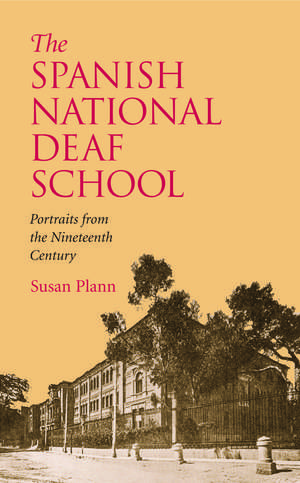The Spanish National Deaf School: Portraits from the Nineteenth Century
Autor Susan Plannen Limba Engleză Hardback – 14 noi 2007
In nineteenth-century Spain, the education of deaf students took shape through various contradictory philosophies and practices. Susan Plann depicts this ambivalence by profiling a select group of teachers and students in her detailed history The Spanish National Deaf School: Portraits from the Nineteenth Century.
Plann’s subjects reveal the political, financial, and identity issues that dominated the operation of the National School for Deaf-Mutes and the Blind in Madrid from 1805 to1899. Roberto Francisco Prádez y Gautier, the first deaf teacher in Spain, taught art from 1805–36; he also was the last deaf teacher for the next 50 years. Juan Manuel Ballesteros, the hearing director from 1835 to1868, enacted an “ableist” policy that barred deaf professors. At the same time, another hearing teacher, Francisco Fernández Villabrille, wrote the first Spanish Sign Language dictionary. In the 1870s, two deaf students, Manuel Tinoco and Patricio García, resisted the physical abuse they received and set the stage for the growth of a Deaf identity that opposed the deprecating medical model of deafness. Marcelina Ruiz Ricote y Fernández a hearing female teacher who taught from 1869 to 1897, combated the school’s sexist polices. The Spanish National Deaf School concludes with Martín de Martín y Ruiz, the most famous deaf-blind student from the Madrid school. Through these portraits, Plann has brought life to the major issues that defined education in nineteenth-century Spain, themes that have influenced the status of deaf Spaniards today.
Plann’s subjects reveal the political, financial, and identity issues that dominated the operation of the National School for Deaf-Mutes and the Blind in Madrid from 1805 to1899. Roberto Francisco Prádez y Gautier, the first deaf teacher in Spain, taught art from 1805–36; he also was the last deaf teacher for the next 50 years. Juan Manuel Ballesteros, the hearing director from 1835 to1868, enacted an “ableist” policy that barred deaf professors. At the same time, another hearing teacher, Francisco Fernández Villabrille, wrote the first Spanish Sign Language dictionary. In the 1870s, two deaf students, Manuel Tinoco and Patricio García, resisted the physical abuse they received and set the stage for the growth of a Deaf identity that opposed the deprecating medical model of deafness. Marcelina Ruiz Ricote y Fernández a hearing female teacher who taught from 1869 to 1897, combated the school’s sexist polices. The Spanish National Deaf School concludes with Martín de Martín y Ruiz, the most famous deaf-blind student from the Madrid school. Through these portraits, Plann has brought life to the major issues that defined education in nineteenth-century Spain, themes that have influenced the status of deaf Spaniards today.
Preț: 322.17 lei
Preț vechi: 373.50 lei
-14% Nou
Puncte Express: 483
Preț estimativ în valută:
61.67€ • 67.01$ • 51.83£
61.67€ • 67.01$ • 51.83£
Carte indisponibilă temporar
Doresc să fiu notificat când acest titlu va fi disponibil:
Se trimite...
Preluare comenzi: 021 569.72.76
Specificații
ISBN-13: 9781563683558
ISBN-10: 1563683555
Pagini: 272
Ilustrații: 1 table, 20 photos
Dimensiuni: 152 x 229 x 23 mm
Greutate: 0.62 kg
Ediția:First Edition
Editura: Gallaudet University Press
Colecția Gallaudet University Press
ISBN-10: 1563683555
Pagini: 272
Ilustrații: 1 table, 20 photos
Dimensiuni: 152 x 229 x 23 mm
Greutate: 0.62 kg
Ediția:First Edition
Editura: Gallaudet University Press
Colecția Gallaudet University Press
Notă biografică
Susan Plann is Professor, Department of Spanish and Portuguese, University of Southern California at Los Angeles, CA.
Descriere
Plann reveals the ambivalence in 19th-century Spanish deaf education by profiling select teachers and students from 1805-1899.
